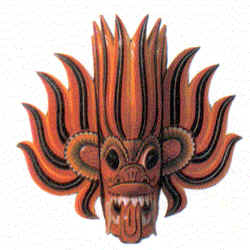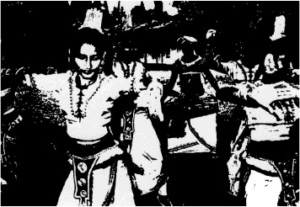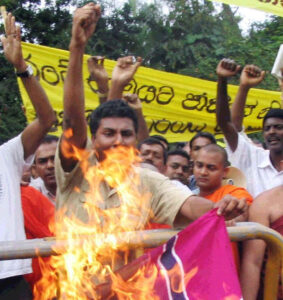by Sachi Sri Kantha
For Sinhalese, the word ‘tovil’ symbolizes something very intimate. Some are too ashamed to openly discuss it. Others consider it as a panacea for the ills afflicting them. For foreign tourists, it is a ‘burlesque show of the male natives.’ For foreign anthropologists, it is a ‘notable cultural tradition which is in the throes of death.’ For the students of alternate medicine, tovil is a healing ritual of some worth. For dance enthusiasts, tovil is synonymous with Sri Lanka.
 First I provide, a nearly 570-word entry on tovil, which appeared in the International Encyclopedia of Dance (edited by Selma Jeanne Cohen; Oxford University Press, 1998, vol.6, pp.183-184). The author of this piece was Michael M.Ames.
First I provide, a nearly 570-word entry on tovil, which appeared in the International Encyclopedia of Dance (edited by Selma Jeanne Cohen; Oxford University Press, 1998, vol.6, pp.183-184). The author of this piece was Michael M.Ames.
“In Sri Lanka, one of the most dramatic forms of dance occurs in exorcist healing rituals variously called, tovil, thovil, toile, yakuma, yakun-natima and yakun-natanava. The tovil is part of the folk tradition of Sinhala-speaking Buddhists, and though not officially a part of Buddhism has been greatly influenced by it.
The techniques of tovil singing and dancing are handed down from teacher to pupil and from father to son (women do not perform); these traditions are said to be two thousand years old. Influences that are also identifiable come from South India, Malasia and Europe – the Portuguese established colonies on the island of Ceylon (now Sri Lanka) – in 1505.
The tovil is performed by exorcists, combating diseases believed to be caused by demons and ghosts. A temporary arena symbolizing the forest, a favorite haunting place for demons, is prepared on level ground near the patient’s house, with a canopy, shrines, and trays for spirit offerings decorated with leaves, strips of banana stem, and coconut fronds. A pallet for the patient is set at one end of the arena. Relatives and friends gather around to offer their sympathies to the patient and to enjoy the performance, which runs from dusk to dawn.
The senior exorcist is usually accompanied by several younger men, who do most of the singing and dancing, and by one or two drummers. The dancers wear costumes and facial makeup; they frequently hold tufts of young coconut leaves or burning torches soaked in coconut oil. Smoke and the smell of incense fill the air.
The dancing begins slowly and grows progressively more energetic, sometimes led by the beat of the drums and sometimes in counterpoint to it. Singing, the chanting of spells and charms, and presentations to gods and demons are interlaced with vigorous dancing and loud drumming. The atmosphere is informal, with people coming and going, visiting and sleeping, eating and playing cards; yet excitement and tension build as the ceremony progresses to a dramatic conclusion. The patient may become possessed by a demon and dance to the rhythm of the drums. The patient must be settled, the gods appeased, and the demons conjured, all before sunrise, if a cure is to be achieved. The conclusion to the ceremony is a series of comic masked dances designed to depict and to placate a particularly nasty set of disease-causing demons.
The tovil drum, the principal musical instrument, is cylindrical, about one foot in diameter and three feet long; and it is fitted with leather and strung together with hide, which can be tightened or loosened to vary the sound. A reed flute, bells, and jingles tied to the arms and ankles complete the dancer’s equipment.
The tovil is a multipurpose performance: a socially integrative and entertaining public gathering of friends and relatives, a ritual dramatization of illness, a cathartic and therapeutic encounter for the patient, and a theological discourse. As monstrous as the demons may appear, they can be combated and subjugated if the proper procedures are followed, and so, by analogy, can other misfortunes of daily life.

Tovil dance
Tovil is today thought to be a dying art, gradually being replaced by Buddhist pietism, Western medicine, and faith-healing cults. The drums can still be heard occasionally in rural areas,however, and – as one of the ironies of the modern world – tovil may be undergoing a modest revival as a form of tourist entertainment in urban areas.”
I’d note that Ames’s lament that tovil is a dying art is rather premature and sadly misdirected. Tovil has mutated into an urban art form. Read the following news item posted in the TamilNet website (September 9, 2004), about Sinhala nationalists burning Norway’s national flag. One can see the parallels between the traditional tovil described by Ames above and the mutated form of political tovil, which is routinely presented in Colombo streets for the press camera. The setting of the exorcist dance has drastically changed, but the actors and the motives remain the same.
“Hundreds of Buddhist monks and Sinhala nationalist activists burnt Norway’s national flag in front of the Norwegian embassy in Colombo Thursday, demanding that the Scandinavian country should stop facilitating talks between the Government of Sri Lanka and the Liberation Tigers. Sinhala nationalist protestors carrying placards and shouting slogans against Norway and the LTTE marched from the Viharamahadevi Park in central Colombo to the Norwegian embassy. ‘This country belongs to Sinhala Buddhists’, ‘Kill LTTE leader Prabhaharan’, the protestors shouted. Protestors burnt Norway’s national flag in front of the embassy on Ward Place, a street in the wealthy suburb of the city.
Eight Buddhist monks then went into the embassy and handed over a memorandum of fourteen questions against Norway’s involvement in Sri Lanka’s peace process. The memorandum was received by a Norwegian diplomat.”

Sinhalese nationalists burning the Norwegian flag 2004
The patients are Sinhala nationalists. Their affliction is a loss of virility of their rata (the state). The demon which has caused such affliction is LTTE leader Pirabhakaran. The patients shout, scream, march, beat their breasts, burn their offering and receive catharcism when they submit a memorandum to a foreign diplomat.
The political tovil has had a life of its own in the Sri Lankan parliament complex since 1956. Though in the traditional tovil only men take part as performers, in the political tovil practised in the parliament, there has been no bar on families or sexes. Any type of swinging among the nuclear members had been permitted in Tamil-baiting, and sticking to a flex time format is the chief rule of the game, depending on whether one is in the government benches or in the opposition. The chief permutations and combinations have been as follows:
(1) husband and wife (S.W.R.D.Bandaranaike and wife Sirimavo; K.M.P.Rajaratne and wife Kusuma; M.H.M.Ashraff and wife Ferial),
(2) father and son (D.S.Senanayake and son Dudley; S.W.R.D.Bandaranaike and son Anura; Philip Gunawardena and son Dinesh; Cyril Mathew and son Nanda),
(3) father and daughter (S.W.R.D.Bandaranaike and daughter Chandrika),
(4) mother and daughter (Sirimavo Bandaranaike and daughter Chandrika),
(5) mother and son (Srimavo Bandaranaike and son Anura),
(6) uncle and nephew (J.R.Jayewardene and Ranil Wickremasinghe)
It has been 50 years now, since Paul Wirz produced his seminal work, Exorcism and the Art of Healing in Ceylon (1954). In it, he identified 18 demons [daha-ata sanniya, in Sinhalese] and their ‘effects’ on the Sinhala psyche. Of these 18 demons, one is even identified by the name, Demala sanniya (literal translation, Tamil demon). Here is the list of 18 demons which terrorise the Sinhala psyche.
Kana sanniya (demon causing blindness)
Kora sanniya (demon causing lameness/paralysis)
Ginijal sanniya (demon causing excess heat)
Vadi sanniya (demon showing guns and shooting in dreams, causing body sores)
Demala sanniya (demon performing pranks and uttering nonsense that sounds like Tamil)
Kapala sanniya (demon causing insanity)
Golu sanniya (demon causing dumbness/muteness)
Bihiri sanniya (demon causing ear diseases)
Maru sanniya (demon causing delirium and death)
Amuku sanniya (demon causing vomiting)
Gulma sanniya (demon causing diarrhea, vomiting, nausea and parasitic worms)
Deva sanniya (demon causing beautiful people in dreams leading to nocturnal emissions)
Naga sanniya (demon causing evil dreams in which snakes prowl around, aching body and bloodshot eyes)
Murta sanniya (demon causing swooning and loss of consciousness)
Kala sanniya (demon causing black death)
Pita sanniya (demon causing bile-related disease)
Vata sanniya (demon causing rheumatism and burning of limbs)
Slesma sanniya (demon causing secretions and epilepsy)
Following the steps of Paul Wirz, other anthropologists and ethnologists like Gananath Obeyesekere, Michael Ames and Bruce Kapferer have contributed their energy to study the maladies of the Sinhala psyche caused by these 18 demons. Bruce Kapferer observed, “It is an anthropological truism that rituals give expression to the social and political dimensions of the context of their performance, and often function to resolve conflicts and problems emergent in the experience of daily life.”
Thus, if you come across any type of news item describing demonstrations by the Sinhalese nationalists (or by their feet-licking proxy represented by Douglas Devananda’s coolie gang) in Colombo, shouting slogans against Pirabhakaran [vide, Pujitha Kuruwita, in the Colombo Daily Mirror, August 20, 2004], just think of it as another political tovil act of exorcism for the press camera by those who are scared of the demon, with the big case ‘D’ – nothing but Demala sanniya.
References:
Ames, Michael: Tovil – exorcism by White Magic. Natural History, January 1978; vol.87, no.1, pp.42-49.
Kapferer, Bruce: A Celebration of Demons – Exorcism and the Aesthetics of Healing in Sri Lanka (Indiana University Press, Bloomington, 1983).